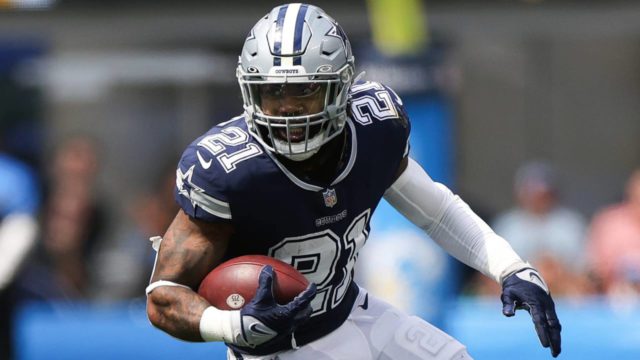The calendar year started in a very unfortunate way for the fans. A good production from the team was expected from the training camp after a season to be forgotten. Dak Prescott’s injury had derailed all plans in week 5 in 2020. However, the return of the quarterback made believe in the possibility of a favorable outcome. That would be out as early as the wild card round.
Several days have passed since the loss at home against the 49ers that put an end to those illusions. The mistakes to get to that disappointing elimination were many. As many as those responsible for not meeting the demanding expectations that the roster had generated. Taking into account that soon it will be time to look forward, there is still some space to qualify the performances of each protagonist.
Today: running backs.
Runners: B-
The season got off to an excellent start in almost every facet of the offense. A nice surprise was the resurgence of the running game in Week 2 against the Chargers. In that duel the Cowboys concluded with 198 yards in that way. Immediately there were 160 against the Eagles, 245 against the Panthers and 201 receiving the Giants.
What’s most interesting about those performances is Kellen Moore’s split between the two running backs on the roster. Ezekiel Elliott posted 71, 95, 143 and 110 in those four games. Tony Pollard’s production consisted of 109, 60, 67 and 75. Although Elliott averaged close to 70% of the snaps, the efficiency of both was unquestionable.
Although that was a mere mirage compared to the rest of the year. That rushing effectiveness faded like the entire team. The low level of the offensive line was partly responsible. However, there was a deciding factor in this drop as Moore’s play selection. There were times when he gave up running the ball too early.
.@EzekielElliott up the middle! 😤#ATLvsDAL | 📺: @NFLonFOX pic.twitter.com/MT3BWKLNDM
— Dallas Cowboys (@dallascowboys) November 14, 2021
As for the individual Pollard had a better contribution than Zeke despite the fact that the total numbers show the opposite. The fourth overall pick in 2016 finished with 1,002 rushing yards and 287 passing yards on 47 receptions. The third-year running back had 719 rushing yards and 337 passing yards on 39 catches. The big difference was in the average per attempt.
Elliott had a passable 4.2 yards per carry, but his teammate had 5.5 every time he rushed the ball. That figure put him third at his position, tied with such stars as the Colts’ Jonathan Taylor and the Browns’ Nick Chubb. For this reason it is very difficult to explain why his explosiveness was not used more frequently.
One relevant point is that Zeke was undoubtedly seen as more confident than last season. It is true that there was a passage in the competition in which he was in poor physical condition due to his knee injury, but he regained some confidence. The inconveniences with the successive fumbles that had plagued his 2020 were left behind this time.
Theres goes Tony Pollard 🏃♂️💨
Down the sideline for a 58-yard touchdown! @Tp__5
📺: #DALvsNO on NFLN/FOX/PRIME VIDEO
📱: https://t.co/LMzEctbvnL pic.twitter.com/a997wSA6QS— NFL (@NFL) December 3, 2021
The area in which he returned his value is in the end zone. There he far outclassed the Memphis graduate. He logically had more opportunities, although it is also fair to point out that he took advantage of them. His 10 rushing touchdowns ranked him sixth in the NFL, so that role may be his primary role going forward.
No one doubts that the Cowboys’ rushing offense noticeably stalled late. However, that had more to do with the collective performance as a unit than with the individual running backs’ performance. A high share of responsibility must be sent to the coordinator for not finding variants that would provide solutions.
Is it a necessity in free agency or the draft?
No. Dallas doesn’t necessarily need to add a running back to the current roster, though the late rounds of the draft are always a good chance to get talent at that spot. The perfect example is 49ers RB Elijah Mitchell. One consideration for management is that Pollard will be entering the final year of his contract. Thinking in advance about a possible replacement is something that should not be ruled out.
Who stays and who goes?
Many surely want to get rid of Elliott because of his contract. That high bond that he got in 2019 is a heavy load. In reality, though, the Cowboys still can’t part with the running back. According to Spotrac, cutting Zeke would take up more cap space than keeping him in the franchise. His cap hit would be $18,220,000, but dead money would be $30,080,000.
The only one who will become an unrestricted free agent when the league schedule begins is a veteran. Corey Clement was signed during the preseason to be the RB3 following Rico Dowdle’s injury. The other running backs like Dowdle, Ja’Quan Hardy, Ito Smith, Sewo Olonilua and fullback Nick Ralston will return to training camp.
We would love to say thanks to the writer of this post for this incredible content
Assessing the Cowboys’ 2021 season: running backs

